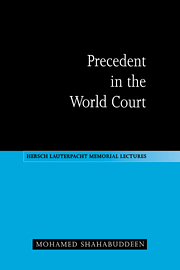Book contents
- Frontmatter
- Contents
- Foreword
- Preface
- List of abbreviations
- 1 Introduction
- 2 The growth of the Court's case law
- 3 Range of precedential resources
- 4 The bases of the system
- 5 The Advisory Committee of Jurists
- 6 The view taken by the League of Nations
- 7 The possibility of judge-made international law
- 8 Stare decisis
- 9 Distinguishing
- 10 Departing from a previous decision
- 11 Ratio decidendi and obiter dictum
- 12 Advisory opinions and decisions of chambers
- 13 The precedential impact of individual opinions
- 14 Effect and scope of the Court's case law
- 15 Conclusion
- Index
- Frontmatter
- Contents
- Foreword
- Preface
- List of abbreviations
- 1 Introduction
- 2 The growth of the Court's case law
- 3 Range of precedential resources
- 4 The bases of the system
- 5 The Advisory Committee of Jurists
- 6 The view taken by the League of Nations
- 7 The possibility of judge-made international law
- 8 Stare decisis
- 9 Distinguishing
- 10 Departing from a previous decision
- 11 Ratio decidendi and obiter dictum
- 12 Advisory opinions and decisions of chambers
- 13 The precedential impact of individual opinions
- 14 Effect and scope of the Court's case law
- 15 Conclusion
- Index
Summary
Introductory remarks
Charles De Visscher correctly drew attention to the ‘Court's concern to assert the unity and coherence of its own decisions’. That concern is noticeably expressed in the care which the Court takes in demonstrating that cases which appear to be in conflict may not involve any inconsistency as between the true principles on which each rests. Cases which rest on different principles are distinguishable; if they are distinguishable, they are not inconsistent. The attention paid by the Court to distinguishing one case from another, even though the initial impression might be that the first was applicable to the second, is an affirmation of its general policy of following its previous decisions.
It is therefore always necessary to determine what were the true principles of the earlier case; to appreciate what exactly was the holding in a case is, indeed, the necessary condition of the functioning of a system of precedent. It was for this reason that it was said at the bar of the Permanent Court of International Justice, and said early in its life, qui bene distinguit bene docet. Even where a case is distinguished, the very process of distinguishing may aid analysis; to cite a general remark made by Fitzmaurice in the course of his arguments in the Reparation case, ‘In order to ascertain what a thing is, it is sometimes very useful to begin by enquiring what it is not.’
- Type
- Chapter
- Information
- Precedent in the World Court , pp. 110 - 127Publisher: Cambridge University PressPrint publication year: 1996



